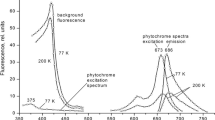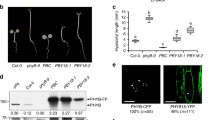Abstract
Higher plants possess multiple members of the phytochrome family of red, far-red light sensors to modulate plant growth and development according to competition from neighbors. The phytochrome family is composed of the light-labile phyA and several light-stable members (phyB-phyE in Arabidopsis). phyA accumulates to high levels in etiolated seedlings and is essential for young seedling establishment under a dense canopy. In photosynthetically active seedlings high levels of phyA counteract the shade avoidance response. phyA levels are maintained low in light-grown plants by a combination of light-dependent repression of PHYA transcription and light-induced proteasome-mediated degradation of the activated photoreceptor. Light-activated phyA is transported from the cytoplasm where it resides in darkness to the nucleus where it is needed for most phytochrome-induced responses. Here we show that phyA is degraded by a proteasome-dependent mechanism both in the cytoplasm and the nucleus. However, phyA degradation is significantly slower in the cytoplasm than in the nucleus. In the nucleus phyA is degraded in a proteasome-dependent mechanism even in its inactive Pr (red light absorbing) form, preventing the accumulation of high levels of nuclear phyA in darkness. Thus, light-induced degradation of phyA is in part controlled by a light-regulated import into the nucleus where the turnover is faster. Although most phyA responses require nuclear phyA it might be useful to maintain phyA in the cytoplasm in its inactive form to allow accumulation of high levels of the light sensor in etiolated seedlings.





Similar content being viewed by others
References
Ballare CL, Scopel AL, Jordan ET, Vierstra RD (1994) Signaling among neighboring plants and the development of size inequalities in plant populations. Proc Natl Acad Sci USA 91:10094–10098
Canton FR, Quail PH (1999) Both phyA and phyB mediate light-imposed repression of PHYA gene expression in Arabidopsis. Plant Physiol 121:1207–1216
Casal JJ, Luccioni LG, Oliverio KA, Boccalandro HE (2003) Light, phytochrome signalling and photomorphogenesis in Arabidopsis. Photochem Photobiol Sci 2:625–636
Chen M (2008) Phytochrome nuclear body: an emerging model to study interphase nuclear dynamics and signaling. Curr Opin Plant Biol 11:503–508
Chen M, Chory J, Fankhauser C (2004) Light signal transduction in higher plants. Annu Rev Genet 38:87–117
Clough RC, Jordan-Beebe ET, Lohman KN, Marita JM, Walker JM, Gatz C, Vierstra RD (1999) Sequences within both the N- and C-terminal domains of phytochrome A are required for PFR ubiquitination and degradation. Plant J 17:155–167
Fankhauser C, Chen M (2008) Transposing phytochrome into the nucleus. Trends Plant Sci 13:596–601
Franklin KA, Quail PH (2010) Phytochrome functions in Arabidopsis development. J Exp Bot 61:11–24
Genoud T, Schweizer F, Tscheuschler A, Debrieux D, Casal JJ, Schafer E, Hiltbrunner A, Fankhauser C (2008) FHY1 mediates nuclear import of the light-activated phytochrome A photoreceptor. PLoS Genet 4:e1000143
Hennig L, Buche C, Eichenberg K, Schafer E (1999) Dynamic properties of endogenous phytochrome A in Arabidopsis seedlings. Plant Physiol 121:571–577
Hiltbrunner A, Tscheuschler A, Viczian A, Kunkel T, Kircher S, Schafer E (2006) FHY1 and FHL act together to mediate nuclear accumulation of the phytochrome A photoreceptor. Plant Cell Physiol 47:1023–1034
Hiltbrunner A, Viczian A, Bury E, Tscheuschler A, Kircher S, Toth R, Honsberger A, Nagy F, Fankhauser C, Schafer E (2005) Nuclear accumulation of the phytochrome A photoreceptor requires FHY1. Curr Biol 15:2125–2130
Huq E, Al-Sady B, Quail PH (2003) Nuclear translocation of the photoreceptor phytochrome B is necessary for its biological function in seedling photomorphogenesis. Plant J 35:660–664
Jabben M, Shanklin J, Vierstra RD (1989) Red light-induced accumulation of ubiquitin-phytochrome conjugates in both monocots and dicots. Plant Physiol 90:380–384
Kircher S, Gil P, Kozma-Bognar L, Fejes E, Speth V, Husselstein-Muller T, Bauer D, Adam E, Schafer E, Nagy F (2002) Nucleocytoplasmic partitioning of the plant photoreceptors phytochrome A, B, C, D, and E is regulated differentially by light and exhibits a diurnal rhythm. Plant Cell 14:1541–1555
Lin R, Ding L, Casola C, Ripoll DR, Feschotte C, Wang H (2007) Transposase-derived transcription factors regulate light signaling in Arabidopsis. Science 318:1302–1305
Mackenzie JM Jr, Coleman RA, Briggs WR, Pratt LH (1975) Reversible redistribution of phytochrome within the cell upon conversion to its physiologically active form. Proc Natl Acad Sci USA 72:799–803
Mathews S (2006) Phytochrome-mediated development in land plants: red light sensing evolves to meet the challenges of changing light environments. Mol Ecol 15:3483–3503
Matsushita T, Mochizuki N, Nagatani A (2003) Dimers of the N-terminal domain of phytochrome B are functional in the nucleus. Nature 424:571–574
Pfeiffer A, Kunkel T, Hiltbrunner A, Neuhaus G, Wolf I, Speth V, Adam E, Nagy F, Schafer E (2009) A cell-free system for light-dependent nuclear import of phytochrome. Plant J 57:680–689
Quail PH (2002) Phytochrome photosensory signalling networks. Nat Rev Mol Cell Biol 3:85–93
Quint M, Ito H, Zhang W, Gray WM (2005) Characterization of a novel temperature-sensitive allele of the CUL1/AXR6 subunit of SCF ubiquitin-ligases. Plant J 43:371–383
Robson PR, McCormac AC, Irvine AS, Smith H (1996) Genetic engineering of harvest index in tobacco through overexpression of a phytochrome gene. Nat Biotechnol 14:995–998
Rockwell NC, Su YS, Lagarias JC (2006) Phytochrome structure and signaling mechanisms. Annu Rev Plant Biol 57:837–858
Rosler J, Klein I, Zeidler M (2007) Arabidopsis fhl/fhy1 double mutant reveals a distinct cytoplasmic action of phytochrome A. Proc Natl Acad Sci USA 104:10737–10742
Saijo Y, Zhu D, Li J, Rubio V, Zhou Z, Shen Y, Hoecker U, Wang H, Deng XW (2008) Arabidopsis COP1/SPA1 complex and FHY1/FHY3 associate with distinct phosphorylated forms of phytochrome A in balancing light signaling. Mol Cell 31:607–613
Schumacher K, Vafeados D, McCarthy M, Sze H, Wilkins T, Chory J (1999) The Arabidopsis det3 mutant reveals a central role for the vacuolar H(+)-ATPase in plant growth and development. Genes Dev 13:3259–3270
Seo HS, Watanabe E, Tokutomi S, Nagatani A, Chua NH (2004) Photoreceptor ubiquitination by COP1 E3 ligase desensitizes phytochrome A signaling. Genes Dev 18:617–622
Shanklin J, Jabben M, Vierstra RD (1987) Red light-induced formation of ubiquitin-phytochrome conjugates: identification of possible intermediates of phytochrome degradation. Proc Natl Acad Sci USA 84:359–363
Sharrock RA, Clack T (2002) Patterns of expression and normalized levels of the five Arabidopsis phytochromes. Plant Physiol 130:442–456
Shinomura T, Nagatani A, Hanzawa H, Kubota M, Watanabe M, Furuya M (1996) Action spectra for phytochrome A- and B-specific photoinduction of seed germination in Arabidopsis thaliana. Proc Natl Acad Sci USA 93:8129–8133
Trupkin SA, Debrieux D, Hiltbrunner A, Fankhauser C, Casal JJ (2007) The serine-rich N-terminal region of Arabidopsis phytochrome A is required for protein stability. Plant Mol Biol 63:669–678
Wagner D, Fairchild CD, Kuhn RM, Quail PH (1996) Chromophore-bearing NH2-terminal domains of phytochromes A and B determine their photosensory specificity and differential light lability. Proc Natl Acad Sci USA 93:4011–4015
Yanovsky MJ, Casal JJ, Whitelam GC (1995) Phytochrome A, Phytochrome B and HY4 are involved in hypocotyl growth-responses to natural radiation in Arabidopsis: weak de-etiolation of the phyA mutant under dense canopies. Plant Cell Environ 18:788–794
Zhang Y, Feng S, Chen F, Chen H, Wang J, McCall C, Xiong Y, Deng XW (2008) Arabidopsis DDB1-CUL4 ASSOCIATED FACTOR1 forms a nuclear E3 ubiquitin ligase with DDB1 and CUL4 that is involved in multiple plant developmental processes. Plant Cell 20:1437–1455
Acknowledgments
We thank Karin Schumacher and Akira Nagatani for providing antibodies against DET3 and phyA respectively, Sérerine Lorrain for critically reading the manuscript and Matthias Zeidler for his kind gift of the fhy1fhl double mutant. Microscopy was performed in the Cellular Imaging Facility platform (CIF) from the University of Lausanne and we wish to thank Arnaud Paradis for his help. Funding was provided by the University of Lausanne and a grant from the Swiss National Science Foundation to C. F. (Grant n° 3100A0-112638).
Author information
Authors and Affiliations
Corresponding author
Electronic supplementary material
Rights and permissions
About this article
Cite this article
Debrieux, D., Fankhauser, C. Light-induced degradation of phyA is promoted by transfer of the photoreceptor into the nucleus. Plant Mol Biol 73, 687–695 (2010). https://doi.org/10.1007/s11103-010-9649-9
Received:
Accepted:
Published:
Issue Date:
DOI: https://doi.org/10.1007/s11103-010-9649-9




